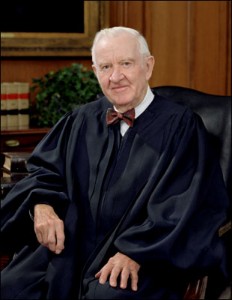John Paul Stevens’ Restraint
 After he retired in 2010, John Paul Stevens published Five Chiefs: A Supreme Court Memoir. After a brief description of the first twelve Chief Justices of the United States Supreme Court, from John Jay through Harlan Fiske Stone, he describes in more detail the last five with whom he was professionally acquainted. Stevens clerked for Wiley Rutledge, after earning the highest GPA in the history of Northwestern Law School, during the 1947 – 48 Term when Fred Vinson was Chief Justice. Stevens was in private practice in Chicago, sometimes teaching antitrust law at the University of Chicago, when Earl Warren presided over the Court. It was during this time, however, that he argued his only case before the Court. In Five Chiefs, he notes that the most memorable aspect of his experience as an advocate before the Court was the sheer proximity of the Justices. Though the distance between the lawyer and the bench is over six feet, Stevens felt sure that “Chief Justice Warren could have shaken my hand had he wished.”
After he retired in 2010, John Paul Stevens published Five Chiefs: A Supreme Court Memoir. After a brief description of the first twelve Chief Justices of the United States Supreme Court, from John Jay through Harlan Fiske Stone, he describes in more detail the last five with whom he was professionally acquainted. Stevens clerked for Wiley Rutledge, after earning the highest GPA in the history of Northwestern Law School, during the 1947 – 48 Term when Fred Vinson was Chief Justice. Stevens was in private practice in Chicago, sometimes teaching antitrust law at the University of Chicago, when Earl Warren presided over the Court. It was during this time, however, that he argued his only case before the Court. In Five Chiefs, he notes that the most memorable aspect of his experience as an advocate before the Court was the sheer proximity of the Justices. Though the distance between the lawyer and the bench is over six feet, Stevens felt sure that “Chief Justice Warren could have shaken my hand had he wished.”
Details like this provide an inside glimpse of the Court. Early in his account, Stevens describes how the prohibition against playing basketball in the gym directly above the courtroom occurred during Vinson’s tenure: Byron White, one of Vinson’s first clerks and a former All-American, was practicing layups during oral argument. Stevens’ anecdotes are always respectful of their subjects and strike one as rather tame, at least until one realizes that civility, the ability to “disagree without being disagreeable,” is of the utmost importance to him.

